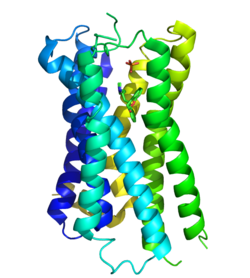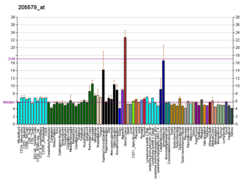The H1 receptor is a histamine receptor belonging to the family of rhodopsin-like G-protein-coupled receptors. This receptor is activated by the biogenic amine histamine. It is expressed in smooth muscles, on vascular endothelial cells, in the heart, and in the central nervous system. The H1 receptor is linked to an intracellular G-protein (Gq) that activates phospholipase C and the inositol triphosphate (IP3) signalling pathway. Antihistamines, which act on this receptor, are used as anti-allergy drugs. The crystal structure of the receptor has been determined (shown on the right/below)[5] and used to discover new histamine H1 receptor ligands in structure-based virtual screening studies.[6]
- ^ a b c GRCh38: Ensembl release 89: ENSG00000196639 – Ensembl, May 2017
- ^ a b c GRCm38: Ensembl release 89: ENSMUSG00000053004 – Ensembl, May 2017
- ^ "Human PubMed Reference:". National Center for Biotechnology Information, U.S. National Library of Medicine.
- ^ "Mouse PubMed Reference:". National Center for Biotechnology Information, U.S. National Library of Medicine.
- ^ Shimamura T, Shiroishi M, Weyand S, Tsujimoto H, Winter G, Katritch V, et al. (June 2011). "Structure of the human histamine H1 receptor complex with doxepin". Nature. 475 (7354): 65–70. doi:10.1038/nature10236. PMC 3131495. PMID 21697825.
- ^ de Graaf C, Kooistra AJ, Vischer HF, Katritch V, Kuijer M, Shiroishi M, et al. (December 2011). "Crystal structure-based virtual screening for fragment-like ligands of the human histamine H(1) receptor". Journal of Medicinal Chemistry. 54 (23): 8195–8206. doi:10.1021/jm2011589. PMC 3228891. PMID 22007643.






